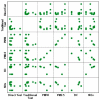Direct Impact of the Air on Mutant Cells for Mutagenicity Assessments in Urban Environments
- PMID: 38276172
- PMCID: PMC10820087
- DOI: 10.3390/microorganisms12010003
Direct Impact of the Air on Mutant Cells for Mutagenicity Assessments in Urban Environments
Abstract
Background: Urban air pollution is recognized as a critical problem for public health and is classified as a carcinogen for humans. A great number of studies have focused on the monitoring of urban air mutagenicity. One of the best-known and applied methods for assessing mutagenicity is the Ames test, a bacterial reverse mutation test. The classic protocol for assessing air mutagenicity involves the concentration of particulate matter (PM) on filters and subsequent extraction using organic solvents. This work aimed to develop a method for the evaluation of air mutagenicity directly impacted by air on microbial plates already containing an Ames' microbial sensor.
Methods: A specific six-month sampling campaign was carried out in Turin in a period with high air pollution. Samples were tested for mutagenicity on Salmonella typhimurium strains TA98, TA100, and YG1024 with the traditional method and with the new direct method.
Results: The new protocol is able to evaluate the mutagenicity of the sampled air and obtain repeatable results. The final sensitivity is similar to the traditional method (≈10 net revertants/m3); however, the mutagenic response is due to the complete air pollution mixture, including volatile and semivolatile pollutants avoiding the concentration of filters and the following laborious extraction procedures.
Conclusions: Despite some critical issues in contamination control, the method is easier, faster, and less expensive than traditional methods.
Keywords: Salmonella assay; air pollution; mutagenicity; urban environment.
Conflict of interest statement
The authors declare no conflict of interest.
Figures



References
-
- WHO . WHO Ambient Air Quality Database, 2022 Update: Status Report. WHO; Geneva, Switzerland: 2022.
-
- EEA . European Union Emission Inventory Report 1990–2014 under the UNECE Convention on Long-Range Transboundary Air Pollution (LRTAP) Publications Office of the European Union; Luxembourg: 2016. - DOI
-
- WHO . WHO Global Air Quality Guidelines. WHO European Centre for Environment and Health; Bonn, Germany: 2021. pp. 1–360.
-
- Keenan C.E., Kelleher R., Gray S.G. Chapter 9—Environmental pollution, epigenetics, and cancer. In: Gray S.G., editor. Translational Epigenetics. 2nd ed. Academic Press; Boston, MA, USA: 2023. pp. 175–194.
-
- EEA Europe’s Air Quality Status 2023. [(accessed on 15 December 2023)]. Available online: https://www.eea.europa.eu/publications/europes-air-quality-status-2023.
LinkOut - more resources
Full Text Sources

